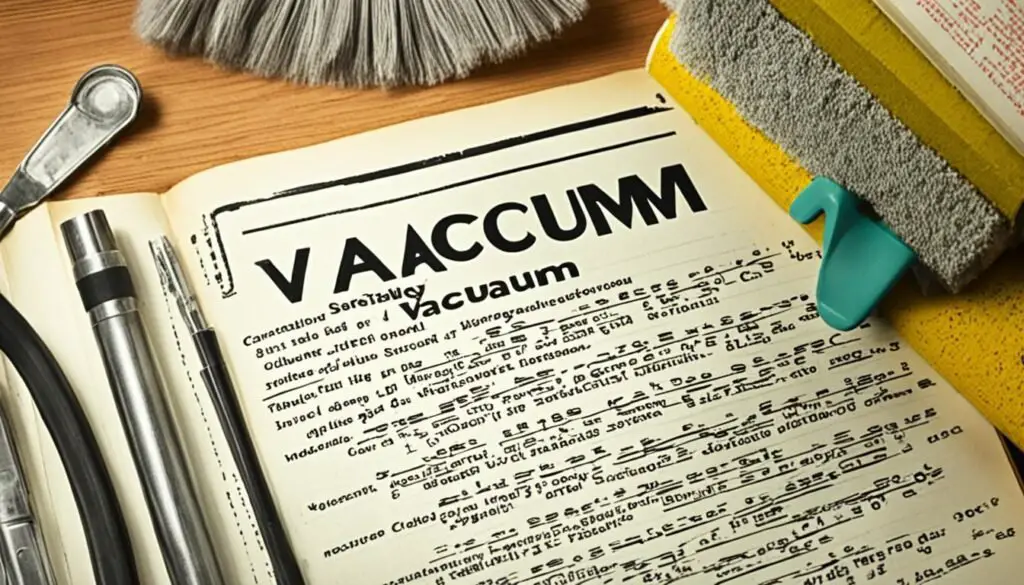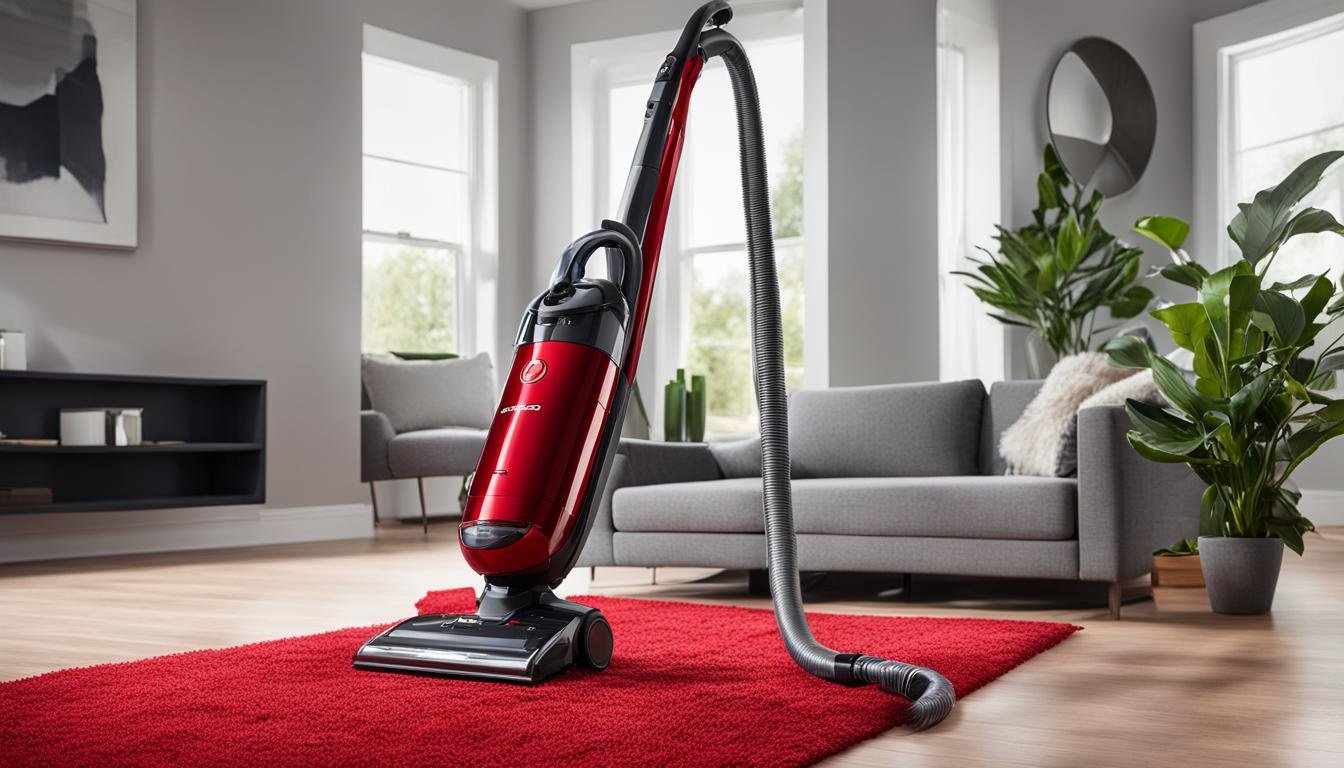Have you ever wondered about the origin of the term “vacuum cleaner”? It’s a fascinating story that dates back to the 19th century and involves one pioneering company – the Hoover Company. Let’s take a closer look at the derivation and meaning behind the word.
The Hoover Company, known for its innovative vacuum cleaner designs, played a significant role in the development of this device. In fact, the word “vacuum cleaner” is derived from the Hoover Company’s brand name. However, it is important to note that the term has become a genericized trademark in some countries, such as the UK and Ireland, where people commonly refer to it as a “hoover.”
In New Zealand, it’s interesting to note that the device is sometimes referred to as a “lux.” But regardless of the different names used around the world, the term “vacuum cleaner” universally describes a device that uses suction to remove dirt from various surfaces.
The early vacuum cleaner models from the 19th century were manual and utilized bellows and rotating brushes. It wasn’t until the turn of the 20th century that motorized designs began to emerge. These motorized models marked a significant advancement in cleaning technology, making the cleaning process more efficient and accessible for homes and businesses.
Key Takeaways:
- The word “vacuum cleaner” is derived from the Hoover Company, which played a pivotal role in the development of the device.
- The term has become a genericized trademark in some countries, such as the UK and Ireland, where “hoover” is commonly used to refer to a vacuum cleaner.
- In New Zealand, the device is sometimes referred to as a “lux.”
- Vacuum cleaners use suction to remove dirt from various surfaces.
- The invention and evolution of vacuum cleaners date back to the 19th century, with manual models using bellows and rotating brushes.
Evolution of the Vacuum Cleaner
The vacuum cleaner has come a long way since its humble beginnings as a manual carpet sweeper in the 1860s. Let’s take a closer look at the fascinating evolution of this essential household appliance.
Early vacuum cleaners were simple contraptions that relied on bellows and rotating brushes to collect dust and debris. However, it wasn’t until the late 19th century that the concept of powered vacuum cleaners started taking shape.
“The first powered vacuum cleaners using suction were independently invented by British engineer Hubert Cecil Booth and American inventor David T. Kenney in 1901.”
Hubert Booth is often credited with coining the term “vacuum cleaner.” His innovative design utilized suction by pumping air through a cloth filter, creating a more effective cleaning mechanism.
Over the years, advancements in technology led to the development of portable vacuum cleaners that could be marketed for home use. These domestic vacuum cleaners became increasingly popular, revolutionizing the way people cleaned their homes.
The Evolution in a Nutshell:
| Stage | Time Period | Key Features |
|---|---|---|
| 1st Generation | 1860s | Manual carpet sweepers with bellows and rotating brushes |
| Powered Vacuum Cleaners | Late 19th century | Air-blowing models, followed by suction-based designs invented by Hubert Cecil Booth and David T. Kenney in 1901 |
| Domestic Vacuum Cleaners | Early 20th century | Portable and marketed for home use |
The evolution of the vacuum cleaner not only improved cleaning efficiency but also made household chores easier and more convenient. It laid the foundation for the modern vacuum cleaners we rely on today.
Stay tuned for the next section as we explore the impact of vacuum cleaners in the modern era and how technology continues to shape their design and functionality.
Vacuum Cleaners in the Modern Era
In the post-World War II era, vacuum cleaners became more common among the middle class. This period marked a significant shift in the adoption and usage of vacuum cleaners, turning them into household staples. The 20th century witnessed remarkable advancements in vacuum cleaner technology, introducing various designs and features that revolutionized the cleaning industry.
One notable development in modern vacuum cleaners is the introduction of filterless cyclonic dirt separation. This innovative technology allows vacuum cleaners to effectively separate dirt and debris from the air without the need for conventional filters. It enhances the performance and efficiency of vacuum cleaners, ensuring powerful suction and minimal loss of suction power over time.
An emerging trend in the modern era is the use of central vacuum systems. These systems are installed in buildings, with a network of pipes running throughout the premises. Users can connect portable hoses to various outlets throughout the building, providing convenient and efficient cleaning in multiple spaces without the hassle of dragging around a heavy vacuum cleaner.
The rise of handheld vacuum cleaners has also been a significant development. These rechargeable devices provide a lightweight and portable solution for quick and easy cleaning. They are ideal for spot cleaning and reaching tight corners and crevices. Additionally, the compact size and cordless operation make them highly convenient for cleaning smaller areas or vehicles.
Another exciting advancement in the modern era is the introduction of autonomous robotic vacuum cleaners. These “smart” devices operate autonomously, using sensors and AI technology to navigate and clean floors without human intervention. Robotic vacuum cleaners have become increasingly popular due to their convenience and ability to clean autonomously, enabling users to focus on other tasks while the vacuum cleaner takes care of the cleaning.
With the diverse needs of both domestic and commercial cleaning, vacuum cleaners are available in various configurations and designs. Upright vacuum cleaners, popular in the US and UK markets, employ a rotating brushroll or beater bar to effectively clean carpets and rugs. They are known for their powerful suction and efficient cleaning performance.

In summary, vacuum cleaners have come a long way since their humble beginnings. The modern era has brought forth significant advancements in technology, resulting in more efficient, user-friendly, and versatile vacuum cleaners. From filterless cyclonic dirt separation and central vacuum systems to rechargeable handheld vacuums and robotic cleaners, there are numerous options available to meet different cleaning needs. These innovations have made cleaning easier, more convenient, and ultimately more effective.
Conclusion
The word “vacuum cleaner” has its origins in the Hoover Company, a key player in the development of this indispensable device. Over time, the term has become a genericized trademark in several countries, notably the UK and Ireland, where “hoover” is commonly used to refer to any vacuum cleaner. The history of the vacuum cleaner dates back to the 19th century, with early manual models employing bellows and brushes to effectively remove dust and dirt.
Powered vacuum cleaners emerged in the late 19th and early 20th centuries, revolutionizing the way we clean our homes. British engineer Hubert Cecil Booth and American inventor David T. Kenney independently invented the first suction-based powered vacuum cleaners around 1901, with Hubert Booth potentially coining the term “vacuum cleaner.” These early models relied on air pumped through a cloth filter to create suction, paving the way for further advancements.
In subsequent years, vacuum cleaner technology has made remarkable progress, resulting in modern configurations and designs tailored to various cleaning needs. From filterless cyclonic dirt separation to rechargeable handheld vacuums and autonomous robotic cleaners, there is now a vacuum cleaner for every household and commercial cleaning job. Upright vacuum cleaners, popular in both the US and the UK, utilize rotating brushrolls or beater bars to achieve thorough cleaning performance.
The language roots and evolution of the term “vacuum cleaner” reflect the ongoing innovations and advancements in cleaning technology throughout history. We owe the convenience and efficiency of these indispensable devices to the commitment of companies like Hoover and the continuous pursuit of excellence in cleaning.
FAQ
Where does the term "vacuum cleaner" come from?
The term “vacuum cleaner” is derived from the Hoover Company, a pioneering company in the development of the device. In some countries like the UK and Ireland, “hoover” is commonly used instead and has become a genericized trademark.
What is the origin of the word "vacuum cleaner"?
The word “vacuum cleaner” may have been coined by British engineer Hubert Cecil Booth, who invented one of the first powered vacuum cleaners using suction in 1901.
How did the vacuum cleaner evolve?
The vacuum cleaner evolved from the carpet sweeper and early manual models developed in the 1860s. Powered vacuum cleaners using suction were invented in the late 19th and early 20th centuries, leading to portable and marketed models for home use.
What advancements have been made in vacuum cleaner technology?
Over time, advancements in vacuum cleaner technology have led to the development of filterless cyclonic dirt separation, central vacuum systems, rechargeable handheld vacuums, and autonomous robotic vacuum cleaners.
How did vacuum cleaners become popular among the middle class?
Vacuum cleaners became more common among the middle class in the post-World War II era.
What configurations and designs are available for vacuum cleaners?
Different configurations and designs, such as upright vacuum cleaners with rotating brushrolls or beater bars, are available for both domestic and commercial cleaning needs.
What are the language roots of the term "vacuum cleaner"?
The language roots of the term “vacuum cleaner” reflect the innovations and advancements in cleaning technology throughout history.





Leave a Reply